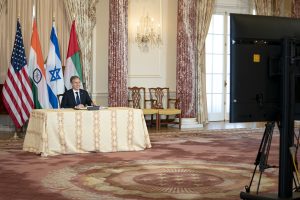Minilateralism appears to be the flavor of the season. After the Indo-Pacific Quadrilateral Security Dialogue, or the Quad – Australia, India, Japan, and the United States – has taken a firmer footing, a second quad is in the making.
The inaugural meeting between the foreign ministers of India, Israel, the United Arab Emirates, and the United States is a significant development. The foreign ministers met on October20 with India’s S. Jaishankar and Israel’s Yair Lapid joining in person while U.S. Secretary of State Antony Blinken and UAE Foreign Minister Sheikh Abdullah bin Zayed Al Nahyan joined the meeting virtually. Jaishankar was on an extended visit to Israel already, and he joined the meeting from there. Coincidentally, two prominent and well-connected Indian analysts referred to the possibility of such a new quad the day before, on October 19.
Interestingly, the foreign ministers of three members of this new quad had met together the previous week in Washington to review the progress in the Abraham Accords between Israel and the UAE, signed in August 2020. This new quad adds India to that trilateral.
This new quadrilateral is significant for four reasons. First, it is a clear recognition that the Biden administration is now actively involved in responding to China in multiple regions. The Biden administration has already re-energized U.S. involvement in the Indo-Pacific. It has not only deepened the Indo-Pacific Quad, but also established AUKUS. Both reflect the Biden administration’s clear intent to meet China’s challenge in the Indo-Pacific region. The establishment of a new quad in the Middle East reflects a recognition that the China challenge goes beyond the Indo-Pacific and has to be met in other regions, too.
Second, the same imperative appears to be driving the Indian involvement as well. After the Galwan confrontation in 2020, and China’s continued intransigence along the Line of Actual Control (LAC), India has become much more enthusiastic about the Indo-Pacific Quad. Note that this enthusiasm was missing after the Doklam confrontation in 2017. In fact, after the Doklam confrontation, India and China held two informal leadership summits at Wuhan and Mamallapuram to try to resolve their differences. Probably as a consequence of these efforts, India dragged its feet on restarting the Quad initiative. India joining this new Middle Eastern quad is a recognition that New Delhi also understands that the China challenge has to be met not only to India’s north and east but also toward India’s west.
The third point to note is that both India and the U.S. now recognize that they need each other to meet these China challenges. The U.S. has always been comfortable engaging with other partners across many regions, but India has never been one of them. India’s material heft now makes it a valuable partner for the U.S., in the Indo-Pacific but also in other regions. This is more of a departure for India, but clearly India also recognizes that the United States is needed to anchor any effort to counter China’s spreading influence. It is also a reflection of India’s growing comfort in dealing with the United States and its trust in Washington, belaying predictions that the U.S. withdrawal from Afghanistan would lead to distrust of the U.S. capacity and commitment elsewhere.
The fourth point to note is that these quads – both in the Indo-Pacific and in the Middle East – are a reflection of the understanding that the China challenge is not just a military one but a far broader matter including political and economic aspects. As Navdeep Suri has noted, China’s influence in the Middle East, particularly in Israel and the UAE, had been growing despite the fact that both are close U.S. security partners. This was not so much a direct security threat – even though there were security concerns also – but a broader expansion of Chinese political and economic influence in the Middle East. While concerns about the Chinese military threat are important, there has not been as much focus on other aspects of China’s power, even though these other aspects are equally vital. Both these quadrilateral groups are a reflection that the U.S. and India are gearing up for this far broader struggle even while they are also intent on meeting China’s direct military pressure.
Finally, Israel and the UAE are good partners for India and the United States. India and the U.S. enjoy good bilateral relations with both Israel and the UAE, which was a necessary facet for building a Middle Eastern quad. Second, both are emerging technology powers in their own right. Israel’s technological prowess in military and civilian areas is well known. Less well known is the fact that the UAE is also gearing up for technological advances in areas such as outer space exploration. The UAE’s recent Mars probe, Hope, is a case in point. In addition, the Abraham Accords brought Israel and the UAE together, thus resolving some of the difficulties of building a Middle Eastern coalition.
Although quads are a particular form of minilateral engagements, they depend on specific conditions. We should expect more minilaterals, even if they are not all going to be quads. As I pointed out elsewhere, the difficulties with traditional multilateralism are leading to a renewed focus on minilateralism, and the new quad is one more example of that.

































